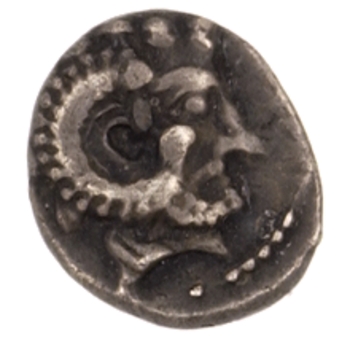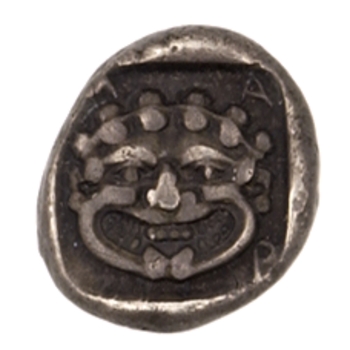Part 1: Was a gorgon featured on the earliest coinage of Mallos?

Classical Numismatic Group, e-auction 174, October 2007, lot 55.
Sometime around 400-300 BC the Greek city of Mallos issued a small bronze coin depicting the gorgon’s head on the reverse.
This bronze type was first published by Imhoof-Blumer. His attribution to Mallos is based on the ΜΑΛ inscription on the reverse of most specimens.
The head on the obverse is identified as the river-god Pyramos, who gave his name to the river Pyramos, because of the letters PY on some specimens. (Imhoof-Blumer identified the young head as “probably” Triptolemos, and that identification appears in older catalogs.)
This wasn’t the only coin from Mallos with a gorgoneion. A very rare obol (four specimens known) in the collection of the American Numismatic Society also features a gorgoneion on the reverse.


The head on the obverse of this coin was identified as Zeus Ammon by the ANS cataloger, but in my opinion could as easily by a river god as on the bronze coin. The silver coin has the inscription Μ-Α-Ρ. It seems strange to see a Greek rho instead of lambda in the abbreviation for Mallos, but the early coins of Mallos did abbreviate the city’s name that way.

Another obol depicting a gorgon was recently sold in a German auction. The type has not been associated with Mallos, but the inscription seems secure. This type is as rare as the first, with only 3 or 4 specimens known.
- Numismatik Naumann, Auction 45, lot 154
- Classical Numismatic Group, e-auction 338, lot 103
- Classical Numismatic Group, e-auction 274, lot 160
Incredibly, the reverse looks exactly like the coinage of Athens. The only difference is the inscription, ΜΑΡ instead of ΑΘΕ.
The style of the gorgon is on this gorgon/owl type matches almost exactly the head/gorgon type. Both gorgons have four pronounced upper teeth and then smaller teeth to either side. The nose and brow are similar. The hair is similar.
The similarity with the coins of Athens doesn’t end there. Athens struck obols featuring a gorgoneion as well. For example, here is one in the collection of the American Numismatic Society.
This coinage of Mallos seems to mule two types associate with Athens. Why?
But wait, there’s more! A very mysterious coin of unknown origin looks very similar to the Mallos/owl coinage.

Classical Numismatic Group, e-auction 174, Lot 73
This unique obol has the ΑΘΕ inscription seen on coinage of Athens! One expert thought the Hebrew letter G, for Gaza, appears on it. There is some precedent for the types in the region. For example CNG 63, Lot 780 also features a gorgon/owl.
The gorgon/ΑΘΕ is poorly preserved but it seems very similar in style and fabric to the Mallos gorgon/ΜΑΡ. It does not resemble the Samarian gorgon/owl. It seems likely that it came from the same place the made the gorgon/ΜΑΡ. If so, it must have been very early, before mint officials realized they must use their own city’s name on its coinage.
The coinage of Mallos is traditional dated as commencing circa 425 BC. The gorgon/incuse obols of Athens are dated 520-509 BC, with the Athena/owl coinage starting soon after that. 425 BC seems much too late for a city to strike the wrong inscription on it's coinage. If the gorgon/ΑΘΕ coinage is a blundered product of Mallos it must be commence early in the fifth century BC, and be among the earliest coinage of the city.






















